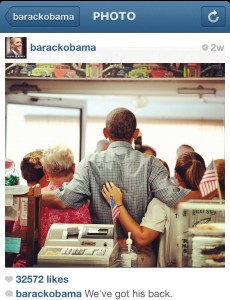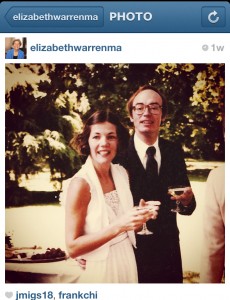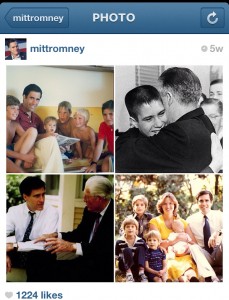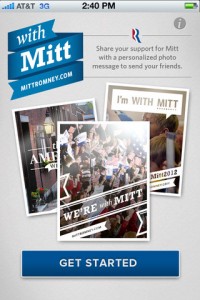Guest article! In the piece below, Beekeeper Group’s Justin Kutner looks at social photo site Instagram as it’s playing out in the 2012 elections. Note that Beekeeper’s Shana Glickfield and Henri Makembe have appeared in our august pages in the past.
Political Trends: Social Media Photography On the Campaign Trail
Sepia-toned photos of architecture and vividly colored snapshots of soup and sandwiches aren’t just for the hipster set anymore. Candidates are embracing Instagram , the photo sharing mobile app recently purchased by Facebook for $1 billion. 2012 is the year of the photo-sharing social network, and Instagram is a powerful tool in the belt of a good online communicator. For the uninitiated: Instagram allows a user to use his or her smartphone’s camera to take a picture, after which he or she can add a variety of effects to the photo, and post the snapshot to the app’s photo sharing section. Users then grow their follower bases and watch as the number of “Likes” and Comments on each photo grows.
Instagram is primarily a mobile device application and functions almost entirely on its user’s mobile devices. Instagram can be in the pocket of virtually every smartphone user, which translates to millions of voters across the country. It’s a simple concept – think Twitter, but for photos.
Democrats
President Obama’s campaign uses Instagram to push put photos of the President as he speaks in front of audiences, to contribute to the larger message of the campaign and to demonstrate that he knows how to hoist babies. In the first week of July, for example, the campaign’s theme was “We’ve got his back.” And this photo appeared on the Instagram feed. Quickly earning over 30,000 Likes, the campaign saw engagement on this somewhat new social media tool grow at rates greatly exceeding the same photo’s engagement on Twitter. With the image earning a comparatively small 704 re-tweets and 287 “Favorites” on Twitter, Instagram saw more users actively engaging with content and having discussions in the comment section of the photo. (This photo earned nearly 1,120 comments, as well.) The Obama camp updates its Instagram account at a rate of nearly four times per week, as well.
The Obama Campaign isn’t the only one on the Democratic side using Instagram to promote messages and appeal to voters and potential supporters. Massachusetts senatorial candidate Elizabeth Warren uses Instagram daily.
Warren staff updates the Instagram feed on nearly the exact same schedule as they update their Twitter feed, indicating that the campaign understands and sees the importance around supporting this newer and supremely active social network.
While the majority of Warren’s photos feature her on the campaign trail interacting with voters at events, Warren has participated in the time-honored Instagram tradition of posting early photos of oneself, such as this photo of herself and husband Bruce she published to celebrate her 32nd wedding anniversary.
Though Warren counts fewer than 30 total followers on Instagram, her campaign is still updating and generating content for the network consistently and with quality content.
Republicans
Democrats aren’t the only ones who’ve been using Instagram , though they may be having more success. President Obama can count over 1.1 million followers on Instagram , while Presidential Candidate Mitt Romney has only 25,000. The Romney campaign has also posted 12 photos, whereas the President’s campaign has posted 91 photos.
Romney’s most recent photo, a four-picture montage of Mitt and his father and family, is over one month old and was posted in celebration of Father’s Day. It’s seen significantly less engagement than any of Obama’s posts. Whether this is indicative of the quality of Romney’s posts, the social-media savvy of his supporters or something else entirely, isn’t clear. What’s obvious, though, is that Obama is winning the Instagram popularity contest.
Romney’s presence on Instagram begs a quick mention of the Romney camp’s foray into the creation of its own photography app, titled With Mitt. Launched the week of May 30th, the app initially proved disastrous. An obvious typo integrated into a key component of the app, (America spelled as “Amercia”) prompted myriad snarky blogs to snipe at the Romney camp. The app itself, which also integrates with the user’s mobile device camera to overlay text with slogans like, “I’m With Mitt”, “I’m a Mom for Mitt”, and “I Stand With Mitt” on a photo, and then allows the user to share the photo with friends via Facebook or Twitter, has over 700 reviews on the iTunes app store, with an overall rating of two and half stars, out of a possible five. The Obama Campaign, on the other hand, does not have its own photography app.
With Mitt deserves the attention of the voter as it’s doing something new, even if the platform wasn’t 100% ready for prime-time. (The typo has since been fixed.) Voters need to embrace new outreach technology in order to spur future growth, which will bring about better and more robust options.
Back on the Massachusetts race, Warren’s opponent and current US Senator Scott Brown doesn’t currently have any campaign presence on Instagram , though he is the subject of some user-generated content. Whenever a user takes a photo of Scott Brown or tags another photo with the hashtag #ScottBrown, Instagram catalogues it, and makes the list available for user’s perusal.
Right now, Instagram is doesn’t have many #ScottBrown tagged photos, and what IS there now isn’t all that flattering. There’s a post tagged with his 1982 Cosmopolitan centerfold, for example. There’s another post tagged with a photo of Brown next to a photo of a two people, one in an alligator costume and one that’s not very NSFW [Ed note: oh my….] There are a couple photos of Brown on campaign stops, but the point I’m making is this: the campaign should recognize the importance and prevalence of photo sharing apps so that they can control the message and what’s popping up for voters who search for Brown online.
Though both sides of the aisle have a presence on Instagram and other mobile photo sharing apps, their presence isn’t equal — at least for now. Obama and Warren have a solid understanding of the app’s uses, while it seems Romney and Brown have more to learn in order to fully engage their users and potential voters in this new space.
It’s all about optics
The introduction of a dedicated Romney photography app speaks clearly to the overall message: photography is becoming a bigger driver of engagement than ever before, perhaps supplanting Twitter and Facebook’s ability to motivate users to interact with content [Ed note: we’ll see….]. Instagram and With Mitt are delivery vehicles of unique content and deserve voters’ attention.
The content delivered by these apps is different from what is posted on Twitter: nearly every Tweet posted by both presidential campaigns over the last week contains a link to an outside site, funneling the user to a 360 degree experience wholly guided by the campaign, whereas no Instagram posts link outside of the app or website itself, forcing the campaigns to operate within its confines.
Because of this, Instagram is being used as a platform to speak to each campaign’s approach. If a voter is viewing the different campaigns through a wholly Instagram med lens, what can they infer about the candidate’ politics?
Take this information as an example:
- Obama has as 1.2 million followers, is Following 11 others and has 95 photos. Romney has 26,000 followers is Following 0 others and has 12 photos total.
- Four (25%) of Romney’s photos prominently feature an American flag; while only four (13%) of Obama’s last 30 photos have any part of a flag in them.
- Obama himself “follows” only 11 users, all of which are official state chapter Instagram accounts of Obama For America, and all have thousands of followers with hundreds of pictures of local state events featuring volunteers, rallies, slogans and quotes.
- Romney, on the other hand, follows exactly zero users on Instagram .
- The Obama Instagram account encourages users to share their own photos with campaign by prefacing the account’s info text with: ” To share a photo with us, use the #Obama2012 hashtag.”
- Romney has no info text.
- All but two of Romney’s photos include the candidate. Only about 30% of Obama’s photos actually include the President in them. The rest are photos of supporters, rallies, Mrs. Obama or are of the Vice-President.
Optics matter for two reasons. First, even the slightest variations between the campaigns are exaggerated as the media and voters look for anything that differentiates the candidates. Look, for example, at how strongly ridiculed Obama was in 2008 for not wearing an American Flag on his lapel while all the other candidates did. He was hounded to the point that he had to acquiesce. You won’t catch him without one now. This small distinction at the time led the media to speculate about the meaning behind the lack of a pin, and a similar scenario could arise on social media, depending on the message and imagery each candidate displays.
Second, optics make the candidate. How does he or she look? Who is he or she meeting with? What are they wearing? Who is appearing at events with them? Candidates are partially defined by who they surround themselves with, and TV can only dedicate so much time to displaying the candidates and talking about them. Social media photo sharing gives users on-demand, 24-hour access to viewing the campaign and analyzing the messages and imagery that the candidate is displaying. This gives the voter the chance to not only be more informed, but to also spend more time engaging with the campaign, a goal for any electoral candidate.
Be there or be (Four)square
Campaigns don’t exist within one app, website or the confines of a 3.5-inch screen. However, I recognize that photo sharing apps are pieces of a larger social media presence. In the high-stakes world of federal electoral campaigning, where every word and every character matters, candidates can’t afford to neglect technologies and software that their opponents are using. Campaigns must be nimble and willing to not only adopt tools like Instagram , but they must know how to use them to grow their communities and manage facilitate user and voter engagement.
Where is the tipping point, though?
Both Obama and Romney are active users of the popular location-based app Foursquare. Foursquare is another mobile app that allows users to “check-in” at any location, gain “badges” for completing special tasks, take a photo while at the location and share their whereabouts with other users.
The Romney camp has posted 11 photos on the site, while The Obama Team has over 100 photos on the site, though Obama’s site is managed by The White House and isn’t used as a campaign tool. Obama’s team uploads about one photo per week, complete with description and comment. All of Romney’s posts are unaccompanied by comments, leaving a litany of non-contextualized photos for users. Foursquare, like Instagram , can be an essential tool in building community online and inciting fanfare around a candidate. It’s got to be used correctly, though.
Not all social media is created equal. There are hundreds of other photo-sharing apps out there too. It isn’t feasible for any campaign to participate in every one of them, but they still need to be wary of being left in the dust by their opponents. Having a good strategy, and going after the apps with the largest reach are clearly the smartest option, but staying on the cutting edge is key
Another important photo sharing opportunity exists on Facebook. The father of all social media, Facebook is where the action really happens. Both camps maintain a lively presence there. At the end of last year, Facebook revamped its approach to photos, placing a greater emphasis on them over text content. Now that photos are larger and more prominent than in the past, taking high-quality and engaging photos is now more important than ever.
Staying on the cutting edge is important for any campaign, even if campaign managers may hesitate to try something new. Voters are becoming more nimble and tech-savvy, as evidenced by the 1 million+ Obama Instagram followers, the 2.8 million Facebook followers Romney has, the 27.5 million Facebook followers President Obama has, the 17.8 million Twitter followers that Obama has and the 800,000+ Twitter followers Romney has. Every one of these followers has the potential to participate in new and ways with the candidates, and it is up to the campaigns to feed their hunger for engagement in the digital space.
When it comes to social media photo sharing applications, if a picture is worth a thousand words, then the lack of high-quality photo sharing presence silences a powerful ally.





Great post! Kutner really knows his topic, I learned quite a bit from this article.
[…] MEDIA ON THE TRAIL. E.politics. “2012 is the year of the photo-sharing social network, and Instagram is a powerful tool in […]
[…] this article: Instagram Gets Political: Social Media Photography On the – e.politics Tweet (function() { var po = document.createElement('script'); po.type = […]
[…] apps and the power of cell phones to help Get Out The Vote below. Also, be sure to look at Justin Justin Kutner’s past piece on social media photography on the campaign trail, which looked at Mitt’s Romney’s Instagram […]